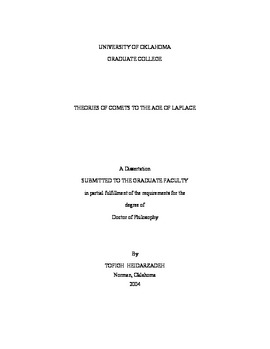| dc.contributor.advisor | Barker, Peter, | en_US |
| dc.contributor.author | Heidarzadeh, Tofigh. | en_US |
| dc.date.accessioned | 2013-08-16T12:19:34Z | |
| dc.date.available | 2013-08-16T12:19:34Z | |
| dc.date.issued | 2004 | en_US |
| dc.identifier.uri | https://hdl.handle.net/11244/808 | |
| dc.description.abstract | The basic question from which this project originated was simple: how did natural philosophers and astronomers define the nature and place of a new category of celestial objects---the comets---after Brahe's estimation of cometary distances? However, a study starting merely from Brahe without covering classical and medieval thought about comets would be incomplete. Thus, based on the fundamental physical characteristics attributed to comets, the history of cometology may be divided into three periods: from Aristotle to Brahe, in which comets were assumed to be meteorological phenomena; from Brahe to Newton, when comets were admitted as celestial bodies but with unknown trajectories; and from Newton to Laplace, in which they were treated as members of the solar system having more or less the same properties of the planets. By estimating the mass of comets in the 1800s, Laplace diverted cometology into a different direction wherein they were considered among the smallest bodies in the solar system and deprived of the most important properties that had been used to explain their physical constitution during the previous two millennia. | en_US |
| dc.description.abstract | Ideas about the astrological aspects of comets are not considered in this study. Also, topics concerning the motion of comets are explained to the extent that is helpful in illustrating their physical properties. The main objective is to demonstrate the foundations of physical theories of comets, and the interaction between observational and mathematical astronomy, and the physical sciences in defining the properties of comets. | en_US |
| dc.description.abstract | The number of publications containing ideas about the physical properties of comets shows a radical increase in the third period of our account of cometology. From numerous general astronomy texts or treatises devoted to comets in this period, those were discussed here that either proposed a different theory of comets or criticized the physical aspects of contemporary theories. The survey includes only works published in England and France, and a few in German-speaking countries. | en_US |
| dc.description.abstract | Although Laplace's achievement in estimation of cometary masses became the basis of modern cometology, our current ideas about the actual size, mass and composition of comets, and the processes by which the coma and tail are formed have been developed only since the mid twentieth century. Post-Laplacian developments in the study of comets are highlighted in an appendix, which briefly reviews the major achievements in the observational and theoretical study of comets in the nineteenth and the twentieth centuries. | en_US |
| dc.description.abstract | Although the development of ideas about cometary motion has been investigated in several projects, a comprehensive and detailed survey of physical theories of comets has not been conducted. The available works either illustrate relatively short periods in the history of physical cometology or portray a landscape view without adequate details. The present study is an attempt to depict the details of the major physical theories of comets from Aristotle to the age of Laplace. | en_US |
| dc.description.abstract | Although the present study is mainly focused on the physical theories of comets, its results will be relevant to studies in the history of geology, planetary science, and astrology. On the other hand, those results may initiate new studies about educational practices for physics and astronomy in post-Newtonian Europe, the ways that different parts of Newton's physical, astronomical and cosmological ideas evolved after him, and the influence of cometary studies on the foundation of astrophysics. | en_US |
| dc.format.extent | vii, 355 leaves : | en_US |
| dc.subject | Physics, Astronomy and Astrophysics. | en_US |
| dc.subject | Comets. | en_US |
| dc.subject | History of Science. | en_US |
| dc.subject | Astronomy. | en_US |
| dc.title | Theories of comets to the age of Laplace. | en_US |
| dc.type | Thesis | en_US |
| dc.thesis.degree | Ph.D. | en_US |
| dc.thesis.degreeDiscipline | Department of History of Science | en_US |
| dc.note | Source: Dissertation Abstracts International, Volume: 65-09, Section: A, page: 3542. | en_US |
| dc.note | Adviser: Peter Barker. | en_US |
| ou.identifier | (UMI)AAI3149289 | en_US |
| ou.group | College of Arts and Sciences::Department of History of Science | |
